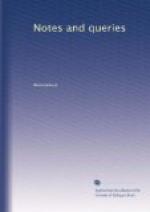F. SOMNER MERRYWEATHER.
Gloucester Place, Kentish Town.
Lady Alice Carmichael, daughter of John first Earl of Hyndford.—John second Lord Carmichael succeeded his grandfather in 1672. He was born 28th February, 1638, and married, 9th October, 1669, Beatrice Drummond, second daughter of David third Lord Maderty, by whom he had seven sons and four daughters. He was created Earl of Hyndford in 1701, and died in 1710.
I wish to be informed (if any of the obliging readers of your valuable publication can refer me to the authority) what became of Alice, who is named among the daughters of this earl in one of the early Scottish Peerages (anterior probably to that of Crawfurd, in 1716), but which the writer of this is unable to indicate. Archibald, the youngest son, was born 15th April, 1693. The Lady Beatrice, the eldest daughter, married, in 1700, Cockburn; Mary married Montgomery; and Anne married Maxwell. It is traditionally reported that the Lady Alice, in consequence of her marriage with one of her father’s tenants, named Biset or Bisset, gave offence to the family, who upon that contrived to have her name omitted in all subsequent peerages. The late Alexander Cassy, of Pentonville, who bequeathed by will several thousand pounds to found a charity at Banff, was son of Alexander Cassy of that place, and —— Biset, one of the daughters, sprung from the above-named marriage.
SCOTUS.
“A Verse may find Him.”—In the first stanza of Herbert’s poem entitled the Church Porch, in the Temple, the following lines occur:—
“A verse may find him, whom a sermon
flies,
And turn delight into a sacrifice.”
Which contain, evidently, the same idea as the one enunciated in the subsequent ones quoted by Wordsworth (I believe) as a motto prefixed to his ecclesiastical sonnets, without an author assigned:—
“A verse may catch a wandering soul
that flies
More powerful tracts: and by a blest
surprise
Convert delight into a sacrifice.”
Query, Who was the author of them?
R.W.E.
Hull.
Daresbury, the White Chapel of England.—Sometime ago I copied the following from a local print:—
“’Nixon’s
Prophecy.—When a fox without cubs shall
sit in the White
Chapel of England, then men
shall travel to Paris without horses, and
kings shall run away and leave
their crowns.’
“The present incumbent of Daresbury, Cheshire (the White Chapel of England), is the Rev. Mr. Fawkes, who (1849) is unmarried. The striking accomplishment—railway travelling and the revolutions of the present year—must be obvious to every one.”
My Query to the above is this: Why is the church of Daresbury called the White Chapel of England, and how did the name originate? The people in the neighbourhood, I understand, know nothing on the subject.




